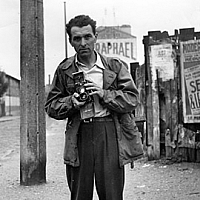
FORMA Centro Internazionale di Fotografia Piazza Tito Lucrezio Caro, 1 I-20136 Milano Italie
On Tuesday 21 September at 18.30, Fondazione FORMA per la Fotografia inaugurates Robert Doisneau, Dal mestiere all’opera and Palm Springs 1960 in collaboration with the Cartier-Bresson Foundation and Atelier Doisneau of Paris.
"I have enjoyed myself throughout my life. I have managed to build my own personal theatre."
Robert Doisneau
A poet of everyday life who preferred the soft-spoken, sharp roughness of simple rhymes to the forcefulness of epic verse, this was Robert Doisneau.
From 21st September to 17th November, Fondazione Forma pays homage to this charming and clear-sighted genius and his tender and amusing photography in two exhibitions that have been conceived in collaboration with the Doisneau family and the Cartier-Bresson Foundation of Paris: Dal mestiere all’opera [From Professional Craft to Artwork] and Palm Springs 1960.
Born in Paris in 1912, Doisneau never detached himself completely from this city. It was his hunting ground, ready to be used, his chosen source of images and emotions. Paris was his world, photography his pretext, curiosity his driving force and lightness his style: nobody else could take such unforgettable photographs, capturing an imperceptible moment of balance, the fruit his rare mastery and its relentless cultivation.
From Professional Craft to Art exhibits a selection of about one hundred original prints, famous images set alongside some previously unseen in public, chosen for the most part from his atelier and from important private collections in France. This extensive selection, further enriched with personal documents and testimonies lovingly collected by the photographer's daughter, provides us with an updated critical rereading, showing us how the apparent spontaneous beauty of his images was, in actual fact, the fruit of considerable work. In practical terms, Doisneau followed through from professional craft to artwork with unexpected seriousness, capturing fragments on film of a world to which he wished to bear witness.
But aside from the streets of Paris, where he encountered and portrayed lovers and children, Doisneau also produced some remarkable and unexpected colour photographs.
In 1960, the magazine Fortune engaged the French photographer to reveal the life of an exceptional city, born like a brilliantly coloured flower in the middle of the Californian desert: Palm Springs. Doisneau accepted the challenge and amid the desert sands, palms and cobalt blue sky, the noisy inhabitants' flashy attire, cocktails and golf courses, he created his own personal American dream, not in black and white but in an explosion of colour. These images from the album Palm Springs 1960, on show for the first time in Italy, reveal a little-known side of this great photographer and even the most seasoned experts will be surprised and carried away by a festive and ironic universe.
Besides, Doisneau always approached his work with a little self mockery, perhaps it was his antidote to the anguish of not being a jester, a tight-rope walker, a magician as he was too much of a realist: and here lies the paradox of one who wished to carry out his work like a street artist, with the chaste joy and fun of an artist malgré lui.
Born in 1912 in a northern suburb of Paris, Robert Doisneau grew up in a Petit bourgeois world he never really loved but from which he never completely detached himself. After finishing his studies he became a draughtsman at Atelier Ullman. In 1931 he was engaged as an assistant by André Vigneau. In 1934 he was employed at the Renault factories: he left this job in 1939 to join the celebrated Rapho photography agency. Between engagements he roamed the streets of Paris and the suburb where he was born. Thanks to the intellectual Robert Giraud, whom he met in 1947, he gained access to a world of night life which was so far from his own and, perhaps for this very reason, completely fascinated him. His first book, a joint project with Blaise Cendrars, La Banlieu de Paris, was published in 1949. Success soon followed, his photos became known all over the world and he became, perhaps without even wanting it, the “portraitist” of a city, Paris, and of a world part real part invented, in which it would be beautiful to live. Until 1994, the year of his demise, he lived with his camera as his constant companion, curious about this little theatre in which he was an actor.

